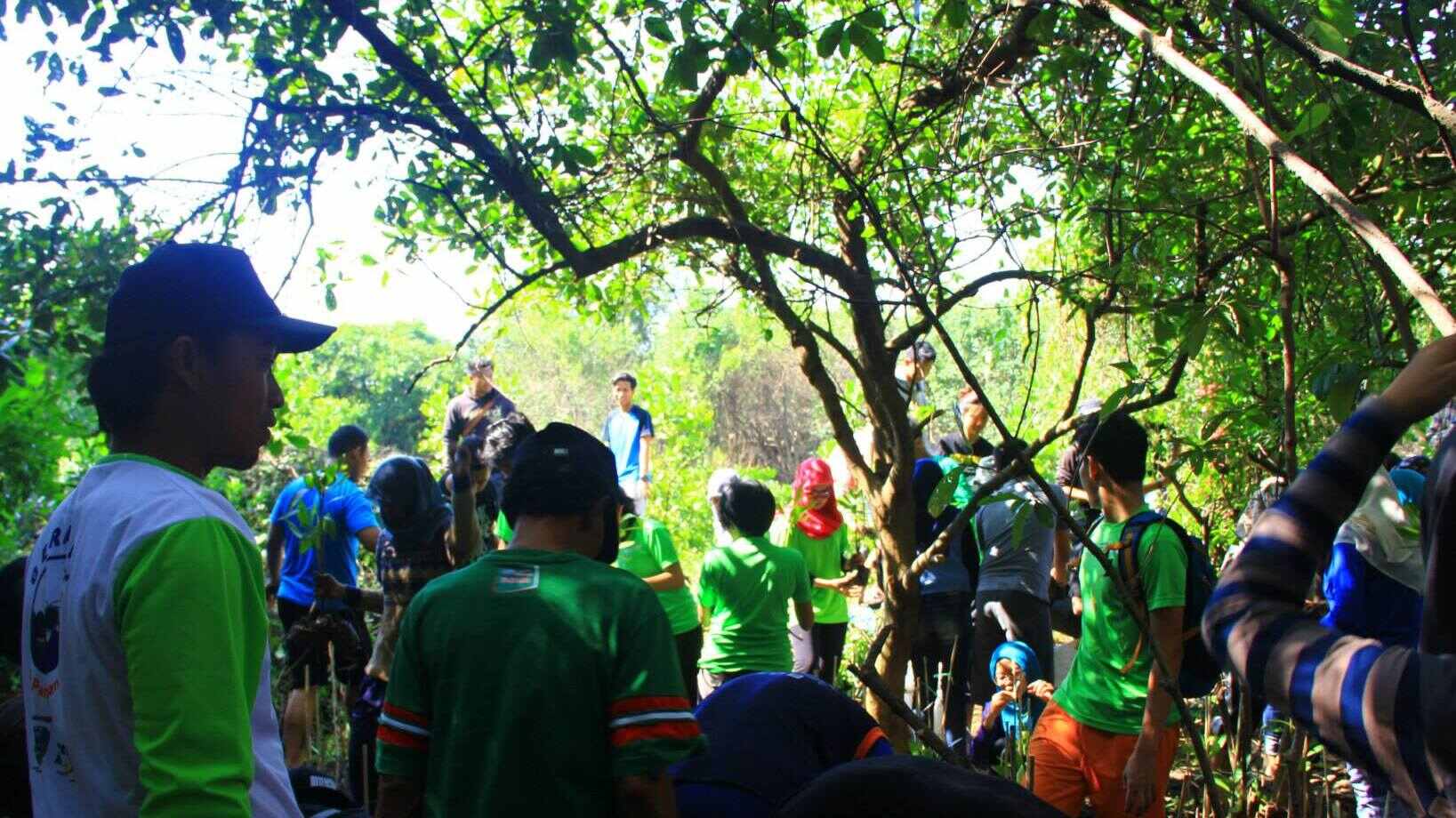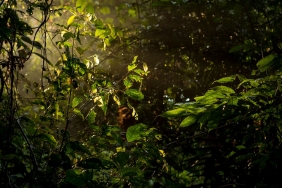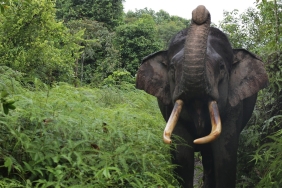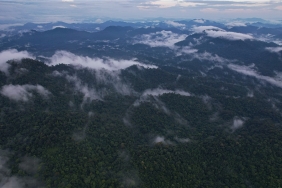TO ADDRESS HUMAN-WILDLIFE CONFLICT, 5 VILLAGES IN KAUR FORM TASK FORCE
The sun is shining brightly this morning. Helping to warm up the red dirt roads that were wet from last night's rain. Finally, school children and residents of Tri Jaya Village can more easily pass by to do their activities. At least, this morning, they were helped. Not much soil stuck to their footwear or vehicles. So there is no need to struggle with vehicles that are stuck due to muddy roads and of course it is easier to clean them later. Not only did the streets warm up, that morning the sunlight greeted us, through the ventilation booths and windows of the living room of Wahyudi, the Head of Tri Jaya Village.
Different from usual, the living room which is often quiet, this morning was crowded with the hustle and bustle of men. These men are representatives from 4 other neighboring villages, namely, Sukajaya, Bukit Indah, Sinar Banten and Sumber Harapan. These villages are assisted by WWF in the Community Empowerment Program in an Effort to Preserve Key Animal Habitat in the Buffer Village of Merpas TNBBS Resort.
Accompanied by a cup of coffee, a casual chat was started while sharing laughter. This time, they gathered in order to participate in the socialization of human-tiger conflict management and the formation of a wildlife monitoring task force. This activity aims to increase public awareness about the importance of Sumatran tigers and how to mitigate human-tiger conflicts, as well as improve community coordination and collaboration as an effort to mitigate Sumatran tiger conflicts.
In 2014, the assisted villages, especially Trijaya and Sinar Banten villages had a bad past with Sumatran Tigers. There was a major conflict where one person was pounced by the Sumatran Tiger and hundreds of goats belonging to the villagers were eaten. Even today, the community still witnesses the tiger crossing the village road several times at dusk. This human-tiger conflict was triggered by land clearing activities or conversion of natural forests into oil palm production forests in 2012-2014 which affected the presence of Sumatran tigers and their prey in the area. This land clearing resulted in a narrowing of the Sumatran Tiger's home range, allowing the tiger to enter the village.
Based on the book Spatio - Temporal Patterns of Human Tigers Conflicts in Sumatra 2001-2016, there were 1065 cases of tiger and human conflicts in all parts of Sumatra. The highest number of conflicts was tigers preying on people's livestock with 376 cases. Second was tigers entering human settlements, with 375 cases. Cases of humans being directly attacked and causing injuries by tigers ranked third with 184 cases. Meanwhile, cases of tigers being snared, poisoned, shot and other hunting activities ranked fourth, with 130 cases.
On this occasion, the community gained more knowledge about "Mbah Kumis" as the local people call the Sumatran Tiger. Not only did they learn more about his profile and habitat, they also learned to understand why tigers enter villages, the importance of protecting forests for their sustainability, and how to deal with human-tiger conflicts when they occur. This knowledge is needed so that people can realize that tigers are not enemies, but creatures that play a role in the balance of the ecosystem. Instead of hating tigers because they are considered disturbing and troubling, understanding the importance of the existence of Sumatran tigers is expected to increase public awareness to protect the habitat of this animal so as to avoid extinction.
The results of a tiger study entitled "Tigers Need Cover" written by a number of tiger researchers from WWF Indonesia, Virginia Tech and supported by the Indonesian Ministry of Forestry in 2012 explained that under certain conditions tigers can use acacia plantations, oil palm plantations, and rubber plantations as their home range. However, considering the availability of prey, tigers tend to avoid plantations and prefer forests. Conditions favored by tigers, in addition to sufficient prey availability, are a short distance from the center point of large forest blocks (>50,000 ha), dense understory cover, and minimal levels of human activity. Based on the results of this study, it is possible that the area around the 5 villages is the tiger's home range and the presence of tigers in these villages can be minimized by maintaining dense forest cover where they live.
In addition to tigers, during this activity the community also mentioned animals that they still encounter when doing activities in the forest or garden when grazing for their livestock or when tapping rubber which is also the main income of these villages. The animals they often encounter include Honey Bear (Helarctus malayanus), Tapir (Tapirus indicus), Beruk (Macaca nemestrina), Long-tailed Monkey (Macaca fascicularis), Squirrel, Pangolin (Manis javanica), Clouded Tiger (Neofelis diardii), Simpai (Presbytis melalophos), Kijang (Muntiacus muntjak), Rusa (Rusa unicolor), Rhinoceros Hornbill (Buceros rhinoceros), Wild Boar (Sus scrofa), Porcupine (Hystrix brachiura), several species of civet and also several species of birds. Some of these animals have also been documented through camera traps that have been installed by the WWF Team.
Based on the support and active participation of each village, a wildlife monitoring task force team was formed, whose members are a combination of representatives from each village. Later, this team will be the frontline of 5 villages in the community's self-help efforts in the event of conflict between humans and wildlife. In its role to follow up on the MoU with the Ministry of Rural Affairs, WWF also encouraged each village to provide support for this activity]. This was also welcomed by each village representative, so that in the future they will oversee this activity so that it can be included in the village budget (ADD). The existence of this team is also expected that the coordination and communication between the community and the area managers (BKSDA & KPH Kaur), as well as WWF Indonesia Foundation will be well established, so that human and wildlife conflicts can be minimized and prevented.
This kind of commitment and active participation of various parties should be improved in order to raise public awareness to protect the existence of animals and their homes. Understanding that just like humans, animals also need a place to live and carry out their activities is important so that humans are willing to share space, and coexist with nature and wildlife. This is the best compromise that can be made by fellow living beings today. Because coexistence will not exist without compromise and tolerance.
To support this, WWF Indonesia implemented a community empowerment program in helping efforts to save tiger habitat, WWF also installed camera traps to monitor the presence of tiger animals that are still found in the area. Hopefully with this, people and wildlife can share space and take care of each other. They can live together.





